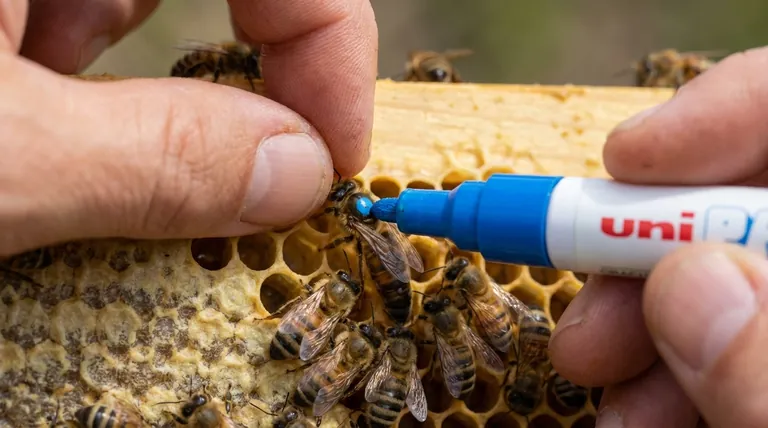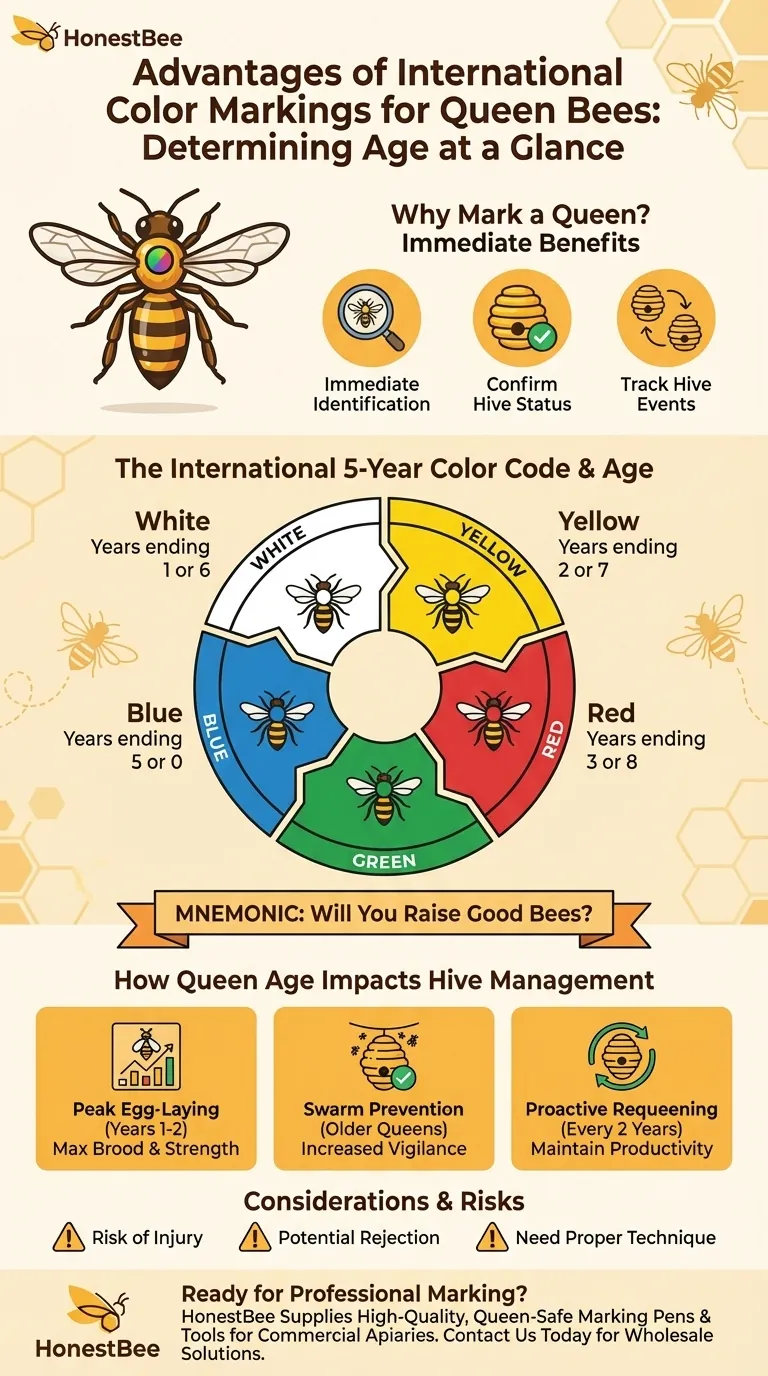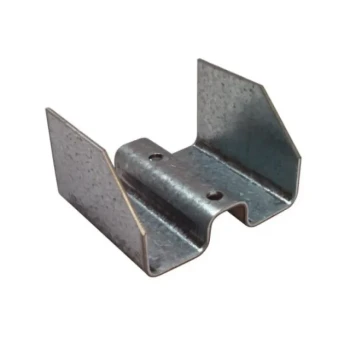The primary advantage of using different colored markings for queens is to determine her age at a single glance. The international beekeeping community uses a standardized five-color system that rotates annually, allowing a beekeeper to instantly know the year the queen was born and began laying eggs.
Marking a queen is a simple practice that provides a wealth of strategic information. The color code is a visual shorthand for the queen's age, which is the most critical factor in predicting a colony's future productivity, temperament, and swarming impulse.

The Foundation: Why Mark a Queen at All?
Before decoding the colors, it's essential to understand the basic benefits of marking a queen, regardless of the color used. A marked queen fundamentally simplifies hive inspections.
Immediate Identification
Finding a single queen bee amongst 30,000 to 60,000 other bees is a difficult and time-consuming task. A bright dot of color on her thorax makes her stand out, turning a long search into a quick confirmation.
Confirmation of Hive Status
A fast and successful inspection often hinges on one question: is the hive "queenright"? Spotting the marked queen immediately confirms her presence and allows the beekeeper to assess her laying pattern and move on, minimizing disruption to the colony.
Tracking Hive Events
If you expect to see a queen marked with last year's color but instead find an unmarked queen, you know a "supersedure" or swarm has occurred. The colony has replaced its old queen, and this knowledge is vital for your management records and decisions.
Decoding the International Color Code
The color system isn't random; it's a global standard that operates on a five-year cycle tied to the last digit of the year. This system allows beekeepers anywhere in the world to know the age of a marked queen.
The Five-Year Cycle
There are five colors in the rotation: White, Yellow, Red, Green, and Blue. Each color corresponds to years ending in a specific pair of numbers.
The Color-to-Year Association
The standard code is as follows:
- White: Years ending in 1 or 6
- Yellow: Years ending in 2 or 7
- Red: Years ending in 3 or 8
- Green: Years ending in 4 or 9
- Blue: Years ending in 5 or 0
For example, a queen hatched in 2023 would be marked Red. A queen from 2024 would be Green.
A Simple Mnemonic
To easily remember the order of the colors (from 1/6 to 5/0), many beekeepers use the phrase: Will You Raise Good Bees?
How Queen Age Impacts Hive Management
Knowing the queen's age is not trivia; it is one of the most powerful predictors of colony behavior and allows for proactive, rather than reactive, beekeeping.
Peak Egg-Laying Years
A queen's egg-laying prowess is at its peak in her first two years. After that, her productivity typically begins a slow decline. A beekeeper seeing a three- or four-year-old queen (e.g., a White queen in a "Green" year) can anticipate lower brood production and a weaker colony.
Swarm Prevention
Colonies with older queens are statistically more likely to swarm. Knowing you have an aging queen allows you to be more vigilant in your swarm management practices, such as providing more space or splitting the hive.
Proactive Requeening
Many commercial beekeepers and serious hobbyists proactively "requeen" their hives every two years. By replacing an aging queen with a new, mated one, they ensure the colony remains strong, productive, and less prone to swarming, maximizing honey production or pollination services.
Understanding the Pitfalls and Considerations
While beneficial, the act of marking a queen is an intervention that carries minor risks. It is a calculated decision, not a mandatory task.
The Risk of Queen Injury
The process requires catching the queen and holding her gently while applying the paint. An inexperienced hand can accidentally damage her leg, antenna, or even fatally crush her.
Potential for Rejection
On rare occasions, the scent of the paint or the stress of handling can cause the worker bees to "reject" their queen. They may surround her in a tight ball (a process called "balling") and kill her. Using queen-safe, fast-drying paint pens minimizes this risk.
The Need for Proper Technique
Marking should be done quickly and calmly. Specialized tools like queen-marking cages or "plungers" can immobilize the queen safely on the comb without direct handling, reducing risk for both the queen and the beekeeper.
Making the Right Choice for Your Apiary
Applying this knowledge depends entirely on your beekeeping goals. The color code is a tool, and you decide how to use it.
- If your primary focus is maximum productivity and swarm control: Use the color code to plan for requeening your hives every two years, before the queen's output and pheromones begin to decline.
- If your primary focus is simplified hive inspections: Marking your queens with any color will dramatically reduce inspection time and stress on the colony, even if you don't follow the annual code.
- If you are a new beekeeper: Consider purchasing queens that are already marked by the breeder to gain the benefits without the initial risk of handling and marking them yourself.
Ultimately, marking your queen transforms a key variable—her age—into a known constant, empowering you to manage your hives with foresight and precision.
Summary Table:
| Color | Corresponding Years (Ending In) |
|---|---|
| White | 1 or 6 |
| Yellow | 2 or 7 |
| Red | 3 or 8 |
| Green | 4 or 9 |
| Blue | 5 or 0 |
Ready to implement a professional marking system in your apiary? HONESTBEE supplies commercial apiaries and beekeeping equipment distributors with the highest-quality, queen-safe marking pens and tools. Our wholesale-focused operations ensure you get the reliable supplies you need to manage your hives with precision. Contact us today (#ContactForm) to discuss your needs and see how we can support your beekeeping success.
Visual Guide

Related Products
- Queen Bee Marking Pen UNI Medium Point for Queen and Bee Marking
- Jenter Queen Rearing Kit Complete Set for Bee Breeding
- Nicot Queen Rearing Kit for Beekeeping and Grafting in Nicot System
- No Grafting Queen Rearing Kit: System for Royal Jelly Production and Queen Rearing
- Retractable Chinese Queen Rearing Grafting Tools Equipment
People Also Ask
- Why is marking a Queen bee important for beekeepers? Elevate Your Apiary Management
- What is the process for priming a paint pen before marking a Queen bee? Ensure a Safe, Quick Marking Procedure
- How should a Posca pen be prepared for queen marking? Ensure a Safe, Precise Mark Every Time
- What type of markers are commonly used for marking Queen bees? Choose the Safe, Non-Toxic Standard
- What are the advantages of using Uni-Posca markers for Queen marking? A Safe, Precise, and Efficient Solution



















